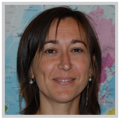Lecturers
Simona Forcella

World Organisation for Animal Health (OIE) - France.
Project officer
Dr Simona Forcella is a veterinarian with specialised in animal health and epidemiology. In Italy she worked at the National Reference Centre for veterinary epidemiology, programming, information and risk analysis where she managed the information coming from the national eradication programme for Brucellosis, Tuberculosis and Leucosis in collaboration with the Veterinary Public Health Department of the Italian Minister of Health.
Since April 2010 she joined the World Organisation for Animal Health (OIE) where she collaborated, among other activities, to the development of the second version of the World Animal Health Information System (WAHIS) and of a new device for the notification of diseases specific for wild animals and its public interface (WAHIS-Wild) and to the training of OIE focal points.
She is now responsible to follow up the dossiers on the recognition of countries’ animal disease official status as well as being a contact point for zoonosis.
OIE Headquarters, France
Tim Carpenter

Massey University - New Zealand.
MS, MS, PhD - Professor of Veterinary Epidemiology and Economics Gilruth Chair in Animal Health Head
I recently retired from the University of California at Davis after a satisfying career of more than 30 years of teaching, service and research; however, unlike those who chose the traditional retirement route, I caught a flight the next day and was at work the following morning to take on a new challenge at Massey University in New Zealand. In addition to my traditional role as a Professor (of Veterinary Epidemiology and Economics), I am the Gilruth Professor of Animal Health, Director of the EpiCentre and Head of the OIE Collaborating Center for Veterinary Epidemiology and Public Health.
My research interests are focused on a variety of methodologies, which I have developed and applied to a variety of animal species and diseases. I have (co)authored more than 230 peer-reviewed manuscripts. I have taught and conducted research in spatial epidemiology since 1990. I have (co)authored two book chapters and approximately 50 peer-reviewed manuscripts on spatial epidemiology.
My animal species and disease focus is equally as diverse as the methods used to study them, including aquatic, wildlife, companion animals and livestock as well as bacterial, viral, protozoan infections and non-infectious diseases, from African swine fever to West Nile virus. Throughout all this, the common thread in my research is a problem-solving approach that provides useful information to an individual pet owner through to decision makers, who are responsible for the wellbeing of large animal populations. Beneficiaries of this work include various agencies, both within the US and abroad, including the US Department of Homeland Security (DHS), the Inter-American Development Bank (IDB), the World Health Organization (OIE), the Food and Agriculture Organization (FAO), several State and Federal Departments of Animal Health, including the US Department of Animal Health (USDA), the US Department of the Interior (USDI), and decision and policy makers around the world, including more than 25 countries from Argentina to Zambia.
Current research that I have become involved with in New Zealand involve epidemiologic investigations of health issues in Pacific salmon, an epidemic of increased mortalities in yellow-eyed penguins in the South Island, the potential impact of foot-and-mouth disease if it were introduced into New Zealand, the Psa outbreak in kiwi fruit and a farm-level financial assessment of a Mycoplasma hyopneumoniae eradication program.
I have mentored approximately 100 MS, MVPM, PhD students and postdoctoral fellows, many of whom have gone on to leadership roles in academia, government and industry both in the United States and abroad. Although my appointment involves minimal teaching at Massey, I continue to lecture and deliver short courses in animal health economics, epidemic modeling, risk analysis and spatial epidemiology.
I have taught and conducted research in spatial epidemiology since 1990. I have (co)authored two book chapters and approximately 50 peer-reviewed manuscripts on spatial epidemiology.
OIE Collaborating Centre for veterinary epidemiology and public health, EpiCentre/mEpilab, Institute of veterinary, animal and biomedical sciences - New Zealand.
Paolo Mulatti

Istituto Zooprofilattico Sperimentale delle Venezie (IZSVe)
DVM, MSc, PhD - Veterinary Epidemiologist
I am a veterinarian and I started working at IZSVe in 2004, during my PhD. Since then I have been involved in the management of Avian Influenza epidemics and data, including studies related to biosecurity at farm and territorial levels. I was also included in the team managing the oral rabies vaccination in foxes, during the 2008-2011 epidemic in north-eastern Italy, and I have contributed to the regional surveillance plan for West Nile Disease in Veneto region.
My main interests include (but are not limited to): epidemiology of infectious diseases in animals (with a particular focus on spatial analysis), mathematical modelling of disease spread, and ecology of vector borne diseases.
Nicola Ferrè

Istituto Zooprofilattico Sperimentale delle Venezie (IZSVe)
GIS Office Coordinator
OIE Collaborating Centre for epidemiology, training and control of emerging avian diseases, Istituto Zooprofilattico Sperimentale delle Venezie - GIS Unit, Italy.
I have started to actively work with GIS in 1993 during the Italian foot-and-mouth disease epidemic. Since then, I have had the chance to experience the usage of GIS in different animal diseases and to learn many facets about GIS application in animal health. I have experienced different type software products, digital mapping, geospatial data and data models, location services and automated generalisation techniques. All this is based on my experience of over 20 years at the IZSVe and research activities at national and international level.
Thanks also to my education from Padua University (bachelor in Statistic in 1992, and degree in Political Science, with a specialization in Political Economy in 1996) and IUAV university of Venice (Master in GIS in 2002, and degree in GIS and Remote Sensing in 2013), I have acquired experience to bridge the gap between the technologist and the user, and to manage GIS programs.
I have competence in ISO TC/211 and OGC standards. I’m also directly involved in several research programmes, and in supervising graduate theses for University of Padua (Veterinary department) and IUAV University of Venice. Finally, I am author or coauthor of over 40 publications including peer-reviewed manuscripts, proceeding of conferences and abstracts.
Nicola Ferrè

Istituto Zooprofilattico Sperimentale delle Venezie (IZSVe)
GIS Office Coordinator
OIE Collaborating Centre for epidemiology, training and control of emerging avian diseases, Istituto Zooprofilattico Sperimentale delle Venezie - GIS Unit, Italy.
I’ve started to actively work with GIS in 1993 during the Italian foot-and-mouth disease epidemic. Since then, I’ve had the chance to experience the usage of GIS in different animal diseases and to learn many facets about GIS application in animal health. I’ve experienced different type software products, digital mapping, geospatial data and data models, location services, and automated generalisation techniques. All this is based on my experience of over 20 years at the IZSVe and research activities at national and international level.
Thanks also to my education from Padua University (bachelor in Statistic in 1992, and degree in Political Science, with a specialization in Political Economy in 1996) and IUAV university of Venice (Master in GIS in 2002, and degree in GIS and Remote Sensing in 2013), I’ve acquired enough experienced to bridge the gap between the technologists and the users, and to manage GIS program.
As coordinator of IZSVe - GIS office, my daily duties regards:
- Setting GIS project goals and objectives with particular reference for the diseases management and analysis;
- Developing GIS policies and procedures for GIS data collection and management;
- Database design and data modelling of spatial databases;
- Project management of software projects and combined hardware/software/data projects;
- Planning, setting budgets, and managing necessary GIS resources;
- Supervising, monitoring and evaluating the work of GIS staff;
- Communication, including giving training courses, dealing with all stages of GIS consumer from GIS user to organization managers;
- Coordinating and leading GIS initiatives with external organizations;
- Evaluating technological advances and promoting the usage of appropriate technology and application.
I’ve competence in ISO TC/211 and OGC standards. I’m also directly involved in several research programmes, and in supervising graduate theses for Padua (Veterinary department) and IUAV University of Venice. Finally, I’m author or coauthor of over 40 publications including peer-reviewed manuscripts, proceeding of conferences and abstracts.
